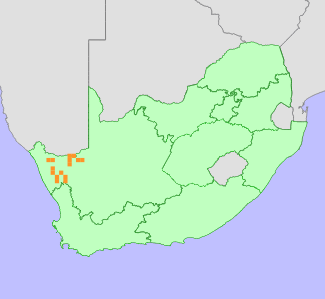|
Scientific Name | Anacampseros quinaria E.Mey. ex Fenzl |
Higher Classification | Dicotyledons |
Family | ANACAMPSEROTACEAE |
Synonyms | Anacampseros alstonii Schönland, Avonia quinaria (E.Mey. ex Fenzl) G.D.Rowley, Avonia quinaria (E.Mey. ex Fenzl) G.D.Rowley subsp. alstonii (Schönland) G.D.Rowley |
National Status |
Status and Criteria | Endangered A4bd |
Assessment Date | 2022/11/20 |
Assessor(s) | N.N. Mhlongo, C. Rodgerson & H. Dreher |
Justification | This species has an extent of occurrence (EOO) of 17 295 km² and an area of occupancy (AOO) of 84 km². The population is declining due to illegal collection of mature individuals to supply the specialist ornamental horticultural trade. The population will experience a decline of at least 50% over a three generation period including two generations in the past (60 years) and one generation into the future (30 years). It therefore qualifies as Endangered under criterion A. This species also occurs in Namibia however the subpopulations there are also suspected to be declining due to illegal collection. The regional status is therefore not downgraded. |
Distribution |
Endemism | Not endemic to South Africa |
Provincial distribution | Northern Cape |
Range | This species occurs in south-eastern Namibia, Bushmanland and north-eastern Namaqualand in the Northern Cape. |
Habitat and Ecology |
Major system | Terrestrial |
Major habitats | Nama Karoo, Succulent Karoo |
Description | Plants are found on rock outcrops. |
Threats |
| The population is declining rapidly as a result of illegal collection with 8449 plants included in confiscations between March 2019 and November 2022, many more are likely to have been removed from the wild but not intercepted by law enforcement efforts. The confiscated plants are usually mature individuals and this is likely to have detrimental impacts on the viability of the wild population. The species is easy to propagate from seed but is seldomly grown commercially as it is slow-growing and cultivation is thus not time nor cost effective, which has resulted in the demand for wild collected plants. It is suspected that many of the plants exported legally from the country may have been wild collected. The CITES trade database has recorded more than 60 000 live plants being exported from South Africa, many of which may have been harvested from the wild. Habitat collected plants of Anacampseros quinaria have been imported into Europe since the 1960s, though in small quantities. These would then be shipped into Asia, mostly China via Hong Kong. Wild specimen of A. quinaria have also been observed at a Czech nursery and on Chinese social media platforms. Both Anacampseros quinaria subsp. alstonii and Anacampseros quinaria subsp. quinaria are affected by poaching but the former is more heavily affected due to its more widespread distribution. A. quinaria subsp. quinaria, with its pink flowers is more desirable to collectors and is more vulnerable due to a relatively restricted distribution. It is seldom affected by grazing due to its low-growing nature. |
Population |
Two subspecies are known, Anacampseros quinaria subsp. alstonii and Anacampseros quinaria subsp. quinaria. The latter occurs on the eastern edge of the Khamiesberg region while the former is found in the Bushmanland to southern Richtersveld. The subpopulations of A. quinaria subsp. quinaria typically consist of small, scattered patches (approximately 10-20 m in diameter) with a high plant density (approximately 10 per square meter), with the next patch being some hundreds metres away. In Anacampseros quinaria subsp. alstonii, a single or very few plants can be found scattered over a large area. Based on the high numbers of plants in confiscations, it is suspected that at least 30% of the South African population of this species has been lost due to poaching since 1960 (two generations). The species remains highly desirable in the ornamental horticultural trade with an increase in confiscations reported since 2019, indicating that a further 30% loss over the next 30 years (one generation) is likely.
|
Population trend | Decreasing |
Assessment History |
Taxon assessed |
Status and Criteria |
Citation/Red List version | | Anacampseros quinaria E.Mey. ex Fenzl | Least Concern | 2015.1 | | Avonia quinaria (E.Mey. ex Fenzl) G.D.Rowley subsp. quinaria | Least Concern | Raimondo et al. (2009) | | Avonia quinaria (E.Mey. ex Fenzl) G.D.Rowley subsp. alstonii (Schönland) G.D.Rowley | Least Concern | Raimondo et al. (2009) | | Anacampseros quinaria E.Mey. ex Fenzl | Indeterminate | Hilton-Taylor (1996) | |
Bibliography |
Gerbaulet, M. 1992. Die Gattung Anacampseros L. (Portulacaceae). I. Untersuchungen zur Systematik. Botanische Jahrbücher für Systematik 113(4):477-564.
Hilton-Taylor, C. 1996. Red data list of southern African plants. Strelitzia 4. South African National Botanical Institute, Pretoria.
Raimondo, D., von Staden, L., Foden, W., Victor, J.E., Helme, N.A., Turner, R.C., Kamundi, D.A. and Manyama, P.A. 2009. Red List of South African Plants. Strelitzia 25. South African National Biodiversity Institute, Pretoria.
Snijman, D.A. 2013. Plants of the Greater Cape Floristic Region 2: The extra Cape flora. Strelitzia 30. South African National Biodiversity Institute, Pretoria.
|
Citation |
| Mhlongo, N.N., Rodgerson, C. & Dreher, H. 2022. Anacampseros quinaria E.Mey. ex Fenzl. National Assessment: Red List of South African Plants version 2024.1. Accessed on 2025/10/17 |
 Comment on this assessment
Comment on this assessment

